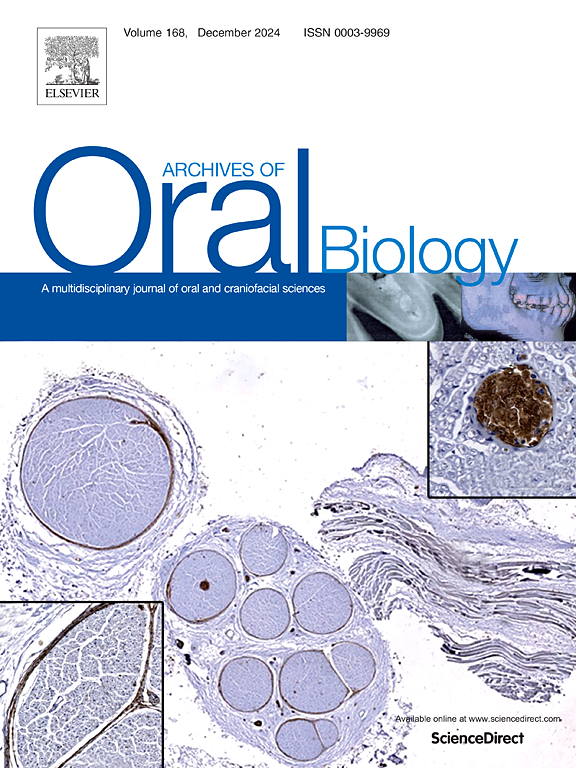Modulation of regenerative responses by retinoic and ascorbic acids in human apical papilla cells
IF 2.1
4区 医学
Q2 DENTISTRY, ORAL SURGERY & MEDICINE
引用次数: 0
Abstract
Objective
This study investigated the bioactive effects of retinoic acid and ascorbic acid on hSCAPs in vitro.
Design
Cells were obtained from human third molars (n=4) and characterized for mesenchymal stem cell markers by flow cytometry. The experimental groups: control (α-MEM); vehicle control group (α-MEM + 0.17 % DMSO); retinoic acid 0.1, 1, and 10 µM; and ascorbic acid 3, 30, and 300 µM (n=8) were tested for cell viability (alamarBlue; 1, 3, and 7 days), total collagen synthesis (Sirius Red; 1 and 7 days), mineralized matrix formation (Alizarin red; 14 days), and the regulation of gene expression related to mineralization (ALPL and DSPP), cell migration (ITGAV and CXCL12) angiogenesis (VEGFA) and collagen synthesis (COL1A1 and COL3A1; RT-qPCR) on 1 and 7 days. ACTB and GAPDH were used as reference genes. Data were analyzed by ANOVA and complementary tests at a 5 % significance level.
Results
Ascorbic acid 300 µM increased viability, and retinoic acid reduced it dose-dependently. Retinoic acid 0.1 µM and ascorbic acid 30 and 300 µM increased mineralized matrix formation and total collagen synthesis, and retinoic acid 10 µM decreased. On day 1, 0.1 µM retinoic acid upregulated the gene expression of COL1A1, COL3A1, VEGFA, CXCL12, ALPL, DSPP e ITGAV, and 300 µM ascorbic acid upregulated COL1A1, COL3A1 and DSPP. However, on day 7, retinoic acid downregulated ALPL, COL3A1, CXCL12, and VEGFA and downregulated ITGAV and VEGFA.
Conclusion
Retinoic acid 0.1 µM and ascorbic acid 300 µM biostimulated hSCAPs to differentiate into pro-regenerative phenotypes with potential application for REPs.
视黄酸和抗坏血酸对人类顶端乳头细胞再生反应的调节作用。
研究目的本研究探讨了维甲酸和抗坏血酸对体外 hSCAPs 的生物活性作用:细胞取自人类第三磨牙(n=4),通过流式细胞术鉴定间充质干细胞标记。实验组:对照组(α-MEM);载体对照组(α-MEM + 0.17 % DMSO);视黄酸 0.1、1 和 10 µM;抗坏血酸 3、30 和 300 µM(n=8),检测细胞存活率(茜草蓝;1、3 和 7 天)、总胶原合成(天狼星红;1 和 7 天)、矿化基质形成(茜素红;14 天),以及 1 天和 7 天内与矿化(ALPL 和 DSPP)、细胞迁移(ITGAV 和 CXCL12)、血管生成(VEGFA)和胶原合成(COL1A1 和 COL3A1;RT-qPCR)相关的基因表达调控。参考基因为 ACTB 和 GAPDH。数据采用方差分析和显著性水平为 5% 的互补检验进行分析:结果:抗坏血酸 300 µM 可提高存活率,而维甲酸可降低存活率,两者呈剂量依赖性。维甲酸 0.1 µM、抗坏血酸 30 µM 和 300 µM 增加了矿化基质的形成和胶原蛋白的总合成,而维甲酸 10 µM 则减少了矿化基质的形成和胶原蛋白的总合成。第1天,0.1 µM维甲酸上调COL1A1、COL3A1、VEGFA、CXCL12、ALPL、DSPP e ITGAV的基因表达,300 µM抗坏血酸上调COL1A1、COL3A1和DSPP的基因表达。然而,在第 7 天,维甲酸下调 ALPL、COL3A1、CXCL12 和 VEGFA,下调 ITGAV 和 VEGFA:视黄酸 0.1 µM 和抗坏血酸 300 µM 可生物刺激 hSCAPs 分化为促再生表型,有望应用于 REPs。
本文章由计算机程序翻译,如有差异,请以英文原文为准。
求助全文
约1分钟内获得全文
求助全文
来源期刊

Archives of oral biology
医学-牙科与口腔外科
CiteScore
5.10
自引率
3.30%
发文量
177
审稿时长
26 days
期刊介绍:
Archives of Oral Biology is an international journal which aims to publish papers of the highest scientific quality in the oral and craniofacial sciences. The journal is particularly interested in research which advances knowledge in the mechanisms of craniofacial development and disease, including:
Cell and molecular biology
Molecular genetics
Immunology
Pathogenesis
Cellular microbiology
Embryology
Syndromology
Forensic dentistry
 求助内容:
求助内容: 应助结果提醒方式:
应助结果提醒方式:


